|
Nature Trail
Birds of paradise
that blossom!
Those of you who journeyed with us on Nature Trail two weeks ago
would remember the magnificent feathered friend called the bird of
paradise we featured in this newspaper. You may also recall we mentioned
the fact that this beautiful birdís name has been given to some plant
species which bear spectacular flowers that closely resemble this bird.
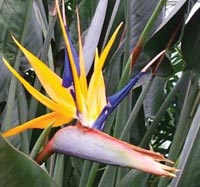 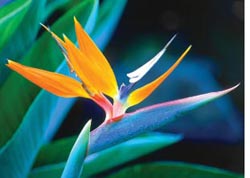 The
pictures depicted here would have already impressed upon you of this
fact and their beauty. The popular bird of paradise plant which is aptly
named for the unique shape of flower that resembles the beak and head
plumage of the bird, and has bright colours, is a member of the
Strelitziaceae family. There are five species of the genus Strelitzia
and they are all native to South Africa. It is also known as the crane
flower in its native land and is considered to be one of the most
colourful flowers in the world! The
pictures depicted here would have already impressed upon you of this
fact and their beauty. The popular bird of paradise plant which is aptly
named for the unique shape of flower that resembles the beak and head
plumage of the bird, and has bright colours, is a member of the
Strelitziaceae family. There are five species of the genus Strelitzia
and they are all native to South Africa. It is also known as the crane
flower in its native land and is considered to be one of the most
colourful flowers in the world!
The five species of this plant which is closely related to the banana
are, white bird of paradise (Strelitzia alba), Mountain Strelitzia (Strelitzia
caudata), white or giant bird of paradise, wild banana (Strelitzia
nicoloai) bird of paradise or crane lilly (Strelitzia reginae) and
African desert banana (Strelitzia juncea).
There are also many hybrids of this plant, which are pollinated by
sunbirds. Today these exotic birds of paradise plants are found in many
warm-weather areas around the world such as Hawaii and southern
California. There are jungle-type bird of paradise flowers such as the
Strelitzia
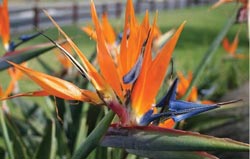 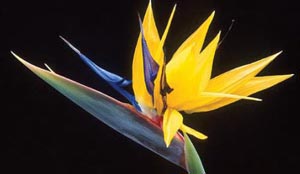 regime
and Strelitzia nicolai, and also desert-type birds of paradise plants
which are unrelated to the jungle type plants.(see box). regime
and Strelitzia nicolai, and also desert-type birds of paradise plants
which are unrelated to the jungle type plants.(see box).
The jungle type birds of paradise plants which are perennials
(lasting through the year), are tropical plants that grow in warm, humid
climates. White/giant bird of paradise or wild banana (S. nicolai) which
is the largest in the genus, grows to a height of 10 metres while the
others typically reach 2 to 3.5 metre heights. The plants which grow
from rhizomes (underground stems) have stiff, erect, leathery concave
and oblong leaves. They are generally bluish-green in colour and are
30-200 cm long and 10-80 cm broad. Even though the leaves are similar to
banana leaves in appearance, they have a longer petiole and are arranged
strictly in two ranks to form a fan-like crown of evergreen foliage. The
leathery leaves are held upright on stiff, leafstalks which are about
six inches wide and eighteen inches long. The evergreen leaves do not
drop from the plant.
 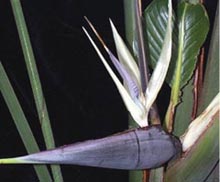 The
exotic flower which is responsible for the popularity of this otherwise
simple, bannana-like plant, is actually a combination of blue petals and
orange sepals that emerge from a beak-like bract (modified leaf). This
hard beak-like bract or sheath from which the flower comes out, is
termed the Ďspatheí. This spathe which is placed perpendicular to the
stem only gives it the appearance of a birdís head and beak. The showy
blossoms which consists of three brilliant orange sepals and three
purplish-blue petals, emerge one at a time. Two of the blue petals are
joined together to form an arrow-like nectary from which the sunbirds
drink the nectar. And when the sunbirds sit on it, the petals open for
the weight, covering the birdís feet in pollen which it then carries to
the next plant it visits, pollinating the plants. The
exotic flower which is responsible for the popularity of this otherwise
simple, bannana-like plant, is actually a combination of blue petals and
orange sepals that emerge from a beak-like bract (modified leaf). This
hard beak-like bract or sheath from which the flower comes out, is
termed the Ďspatheí. This spathe which is placed perpendicular to the
stem only gives it the appearance of a birdís head and beak. The showy
blossoms which consists of three brilliant orange sepals and three
purplish-blue petals, emerge one at a time. Two of the blue petals are
joined together to form an arrow-like nectary from which the sunbirds
drink the nectar. And when the sunbirds sit on it, the petals open for
the weight, covering the birdís feet in pollen which it then carries to
the next plant it visits, pollinating the plants.
Desert-type bird of paradise plants
The desert-type variety which is totally unrelated to the jungle-type
variety comprises shrubs and small trees.
They are native to tropical or sub tropical regions of the Western
Hemisphere and belong to the Caesalphina genus in the legume family.
They include the red bird of paradise (Caesalphina pulcherrima), Mexican
bird of paradise (Caesalphina mexicana) and yellow bird of paradise (Caesalphina
gilliesii).Even though the plants and the flowers of these three
varieties are not as large as the Strelitzia genus, the flowers are
colourful and spectacular. The flowers which come out in clusters and
are different in shape to the flowers in the jungle variety, resemble
azalea flowers when fully open.
The Mexican bird of paradise and yellow bird of paradise both have
yellow coloured blossoms while the red bird of paradise has red blossoms
as the name suggests. However, some people mix up red bird of paradise
plants with the Mexican variety. There are different shades of these
flowers such as the pink due to hybrids.
All three types of this group of plants thrive in dry conditions and
are known to be drought tolerant plants. The seeds of all these plants
are said to be toxic.
Some of the other common names by which these flowers are known
include Peacock flowers, Pride of Barbados and Poinciana (not to be
mistaken with poinsettias which are popular during the Christmas
season).
**********
Fact file:
* Birds of paradise flowers bloom from September through May.
* The herbaceous plant makes an attractive landscape plant in
Florida, but it needs protection from the cold in the southern part of
the state. Freezing temperatures damage the developing flower buds and
flowers. It can however tolerate temperatures as low as 24 degrees
Farenheit, for a short period of time.
* Healthy, mature plants can produce as many as three dozen flower
spikes a year. These would last up to two weeks even after its cut.
* Birds of paradise which belong to the Strelitziaceae family contain
other related species such as Strelitzia parvifolia
* The genus name (the scientific name Strelitzia) is given after the
Dutchess of Mecklenburgh - Strelitz, birthplace of Queen Charlotte of
UK.
* Bird of paradise plants especially Strelitzia reginae are
cultivated on a commercial scale as ornamental flowers in warmer regions
of California and Hawaii and as a greenhouse plant in other regions.
* When growing this plant, dead plant material has to be removed
promptly as a precaution against fungal attacks. Proper watering and
fertilizing is also very important.
* Blooms appear intermittently most of the year.
Facts & pix: internet
********** |

